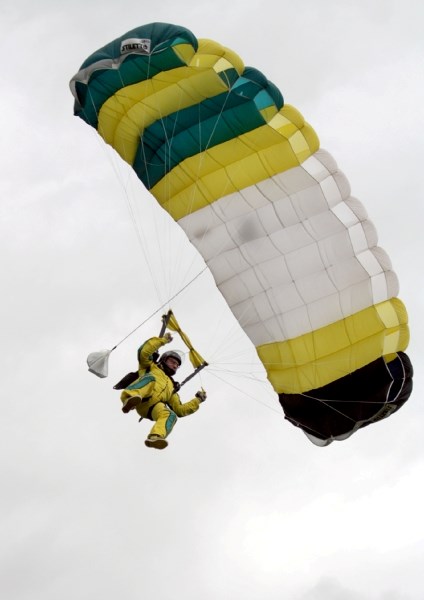Under normal circumstances, falling from the sky would be a cause for concern, but for more than 200 men and women at the Westlock Airport last week, it was just another day of doing what they love.
Well, it was actually more than that, as they were taking part in the 2011 Canadian Skydiving Nationals, hoping to either earn a spot on the Canadian national team or simply show off their skills, said Al Christou, spokesperson for the Edmonton Skydive Club, which hosted the event.
Up until the skies opened up on Friday, Christou said the weather was just what they needed to jump, and the event ran smoothly and on schedule.
“It’s been perfect,” he said. “We were on schedule up until 6:30 p.m. on Thursday.”
By that time, all the selection events had been completed, he said, and only the participation events remained.
During the 10-day event, a number of Canadian and world records were set, Christou said. Among them was the female national record for the most number of points accumulated in a freefall, and a Canadian record for the four-way formation skydive of 16 forms performed during a 35-second drop.
The event drew divers from all across the country.
Toronto’s Paul Cincinnato has been skydiving since 1995 when he first jumped with the military. While with the military, he said a lot of attention was paid to training and ensuring the jumps were safe. When he returned to civilian life, he said he saw how equally safe the jumps were.
At the competition, he took part in the four-way formation skydive and the two-way canopy skydive events.
As a skydiver, he said he’s attracted to the sport because it’s basically like any other.
It’s something that is exciting, interesting and new, and there’s always the desire to get better and to continue to train and improve.
Then there’s the camaraderie amongst all skydivers.
“It’s a very tight-knit community,” Cincinnato said. “There aren’t that many sports where you can approach a member of the national team for help. There’s always someone you can approach and they’re willing to help.”
Monique Andrie is another jumper who came out to compete.
She started jumping in 1989 when she and a few friends went to Maui and were looking for something to do that was “stupid” and didn’t cost much.
Skydiving proved to be just the thing, although she doesn’t remember much of her first jump.
“I was really excited, but not scared,” she said. “However, the second jump was terrifying because I knew what to expect.”
Since those early days, she’s just fallen in love with the rush of adrenaline and the feeling of flying the sport gives her.
On the other hand, the one thing she wants everyone to know is the level of risk involved with skydiving.
“It’s dangerous, and anyone who says it isn’t is lying,” she said.
However, she stresses there are multiple backup devices in place in case something does go wrong, and all jumpers undergo a lot of training before they are allowed to jump.
Christou said over the course of the event, more than 3,000 jumps were performed, and no injuries were suffered. There were four instances of parachutes malfunctioning, which required the divers to open their reserve chutes. Considering that on average a reserve chute is needed once every 400 jumps, he said this was a very safe event.



